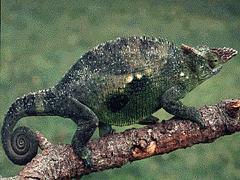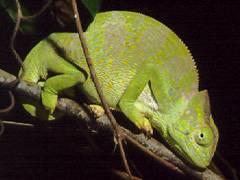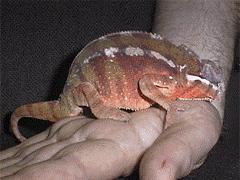Difference between revisions of "Chameleon"
| (13 intermediate revisions by 3 users not shown) | |||
| Line 1: | Line 1: | ||
| − | {{ | + | {{review}} |
| + | [[Image:Chameleon1.jpg|300px|thumb|right|'''Chameleon''' (Copyright © RVC)]] | ||
| + | |||
Scientific name: ''Chamaeleo'' spp. | Scientific name: ''Chamaeleo'' spp. | ||
| − | + | ==Introduction== | |
The following three species of chameleonare among those species seen most often in captivity: | The following three species of chameleonare among those species seen most often in captivity: | ||
| Line 17: | Line 19: | ||
==Enclosure== | ==Enclosure== | ||
| + | [[Image:Chameleon2.jpg|300px|thumb|right|'''Chameleon''' (Copyright © RVC)]] | ||
Chameleons are considered among the more delicate of lizards. Their captive requirements are poorly understood. A glass or wooden vivarium is ideal with living plants. | Chameleons are considered among the more delicate of lizards. Their captive requirements are poorly understood. A glass or wooden vivarium is ideal with living plants. | ||
| Line 69: | Line 72: | ||
==Panther Chameleon (''Chamaeleo pardalis'')== | ==Panther Chameleon (''Chamaeleo pardalis'')== | ||
| + | [[Image:Chameleon3.jpg|300px|thumb|right|'''Panther chameleon''' (Copyright © RVC)]] | ||
===Description=== | ===Description=== | ||
| Line 127: | Line 131: | ||
Not yet captive-bred. Egg laying: 25 or more eggs per clutch. Females are often weakened after egg laying and need to be given regular attention to rehydrate and require hand feeding until they are back into condition. Egg retention is very common due to the lack of suitable sites for oviposition. | Not yet captive-bred. Egg laying: 25 or more eggs per clutch. Females are often weakened after egg laying and need to be given regular attention to rehydrate and require hand feeding until they are back into condition. Egg retention is very common due to the lack of suitable sites for oviposition. | ||
| + | |||
| + | ==Literature Search== | ||
| + | [[File:CABI logo.jpg|left|90px]] | ||
| + | |||
| + | |||
| + | Use these links to find recent scientific publications via CAB Abstracts (log in required unless accessing from a subscribing organisation). | ||
| + | <br><br><br> | ||
| + | [http://www.cabdirect.org/search.html?q=(od:(Chameleon)+OR+title:(Chameleon)+OR+ab:(Chameleon)+OR+od:(Chameleo)+OR+title:(Chameleo)+OR+ab:(Chameleo))&fq=sc:%22ve%22 Chameleon (''Chameleo'' spp.) publications] | ||
| + | |||
| + | [http://www.cabi.org/cabdirect/FullTextPDF/2010/20103181632.pdf '''Old world chameleons: the top ten list of clinical problems and how to address them.''' Stahl, S. J.; The North American Veterinary Conference, Gainesville, USA, Small animal and exotics. Proceedings of the North American Veterinary Conference, Orlando, Florida, USA, 16-20 January 2010, 2010, pp 1717-1719, 10 ref. - '''Full Text Article'''] | ||
| + | |||
| + | [http://www.cabi.org/cabdirect/FullTextPDF/2009/20093018975.pdf ''' Oculonasal flush in chameleons.''' Coke, R. L.; The North American Veterinary Conference, Gainesville, USA, Small animal and exotics. Proceedings of the North American Veterinary Conference, Volume 22, Orlando, Florida, USA, 2008, 2008, pp 1741-1742, 5 ref. - '''Full Text Article'''] | ||
| + | |||
| + | [http://www.cabi.org/cabdirect/FullTextPDF/2009/20093018973.pdf ''' Chameleons: technicolor biology in action.''' Coke, R. L.; The North American Veterinary Conference, Gainesville, USA, Small animal and exotics. Proceedings of the North American Veterinary Conference, Volume 22, Orlando, Florida, USA, 2008, 2008, pp 1736-1738, 3 ref. - '''Full Text Article'''] | ||
| + | |||
| + | [[Category:Lizard_Species|C]] | ||
| + | [[Category:Lizard_and_Snake_Glossary]] | ||
Latest revision as of 13:06, 2 November 2010
| This article has been peer reviewed but is awaiting expert review. If you would like to help with this, please see more information about expert reviewing. |
Scientific name: Chamaeleo spp.
Introduction
The following three species of chameleonare among those species seen most often in captivity:
- Jackson's chameleon - C. jacksoni
- Panther chameleon - C. pardalis
- Parson's chameleon - C. parsoni
Description
In shape, chameleons are high sided and laterally compressed. They have small prehensile tails. The blunt, bony head is adorned with horns, crests and flaps. The skin is granular with an often larger tuberculate scale protruding. They are capable of rapid and drastic changes of colour associated with any of a large number of factors.
The long tongue is thickened at its terminal portion like a club and it can be projected rapidly and accurately. The prehensile tail (which can be used to anchor the lizard to its perch) and the oppositely opposed digits are adaptations to an arboreal existence. The independently rotating, turret-like eyes means chameleons can concentrate on two or more widely separate objects.
In captivity these lizards climb slowly and deliberately along branches looking for insect food and drinking droplets of water trapped on leaves.
Enclosure
Chameleons are considered among the more delicate of lizards. Their captive requirements are poorly understood. A glass or wooden vivarium is ideal with living plants.
The substrate should be a compost/sand mix and should be around 20 cm to facilitate planting and oviposition. The more heavily-planted your vivarium, the more secure the chameleon will feel.
It is important for the vivarium to be well-ventilated and positioned in a well-lit area.
Artificial UV light is of value but natural sunlight is superior.
Chameleons will not drink from a water bowl. They must have the cage lightly misted 1-2 times daily. Beware of the cage becoming too humid. Alternatively incorporate a drip feeder.
Diet
A good variety of foods is essential. Most individuals refuse a type of food that has been offered exclusively for several days running, but will go back to it after a different food has been given for a while. Suitable food items include locusts, crickets, flies and caterpillars or waxworms. Insects should be nutrient loaded and dusted with good quality supplement.
Temperature
For most species the temperature seems not to be critical. 23-30ºC is probably ideal with a slight drop at night.
Jackson's Chameleon (C. jacksoni)
Description
Adults reach 30-40 cm, but smaller forms exist. Males are the same size as females. Males have three distinctive horns; a long curving horn projects from its snout, and two others are rooted above its eyes. They have evolved for the purpose of display and may be used for jousting if two males meet on a branch. Females have only rudimentary horns. Horn stubs are also visible on male hatchlings.
The body is usually bright green. It may turn pale green with brown spots, or completely brown. The area around each eye is usually turquoise. The serrated crest running along the ridge of the back is usually yellow.
Relative air humidity of 50-60% is recommended with good ventilation. They can be kept in pairs in larger enclosures. Longevity in captivity is eight years plus. Juveniles have a low tolerance for stress and neglect and can be difficult to rear.
Range
East Africa.
Diet
Adults should be fed locusts, crickets, small land snails and small vertebrates. Juveniles can be fed week-old crickets and wingless fruit flies; two to three feedings daily is recommended. Insects should be nutrient loaded and supplemented.
Enclosure
A high altitude species in the wild. Fares best when kept as a montane/highland species. Require a large cage with freedom to roam. Specimens will often confine themselves to one area for most of the time. Quarantine is important.
Temperature
Adults should be maintained at temperatures of 24-29ºC during the day with a marked temperature drop at night. Adults are capable of tolerating very low night-time temperatures. For juveniles, recommend 27ºC daytime and 16ºC minimum night-time temperature.
Breeding
Viviparous
Breeding has been achieved in captivity. Gestation about three months. Thirty young, 4-6 cm, being born usually September to December. Rearing juveniles singly may increase success. Maturity is reached in one year under optimum conditions.
Panther Chameleon (Chamaeleo pardalis)
Description
Males up to 50 cm, females usually under 33cm. Males have a more developed helmet and are very variable in colour. Some forms are turquoise, others are green with varying amounts of red, some have extensive orange, and some have bright cobalt blue spotting. Females are more reclusive and nervous than males.
One of the best-adapted chameleons for indoor keeping. Captive longevity in males, eight year plus.
Range
Madagascar and the islands of Mauritius and Reunion (introduced).
Diet
See general discussion above.
Enclosure
See general discussion. Adults can be kept in pairs or trios in very large enclosures, otherwise are best kept singly.
Temperature
Recommend daytime temperature of 30-32ºC, night-time minimum 22ºC.
Breeding
'Oviparous
Produces multiple clutches within a breeding season. Recommend incubation temperature 26-27ºC. Juveniles are best raised singly. Males of this species are probably the best choice for anyone wishing to own a single chameleon as a pet. Best choice for an indoor species.
Parson's chameleon (C. parsoni)
Description
Parson's chameleons are one of the largest and most spectacular of chameleons. Adults grow to 60 cm. Males are larger than females. Males have enlarged and projecting ornaments above and in front of the nostrils. Colour in males also differs from that of females. Adult males have a turquoise coloration and can adopt a pattern with reddish to orange bands. The eyelids are a bright yellow-orange. Females are typically green with a single bright yellow spot on each side. They can adopt a pattern with dark cross bands. The eyelids are yellow.
Parson's chameleons are very sluggish in comparison to other chameleons.
It can be difficult to obtain the proper environment and husbandry. Overall, these chameleons are not very tolerant of stress.
Range
Madagascar.
Diet
Newly imported specimens can be reluctant to feed on crickets but will feed on larger grasshoppers, king mealworms and cockroaches. Occasional hand feeding of fuzzy mice recommended. Some may take mice on their own.
Enclosure
See general discussion. Needs high relative air humidity. A misting system recommended in large displays. Need abundant water.
Temperature
This species does not tolerate extremes of heat or cold. Best kept at 27-29ºC during the daytime. Night temperature should not drop below 19ºC.
Breeding
Not yet captive-bred. Egg laying: 25 or more eggs per clutch. Females are often weakened after egg laying and need to be given regular attention to rehydrate and require hand feeding until they are back into condition. Egg retention is very common due to the lack of suitable sites for oviposition.
Literature Search
Use these links to find recent scientific publications via CAB Abstracts (log in required unless accessing from a subscribing organisation).
Chameleon (Chameleo spp.) publications



